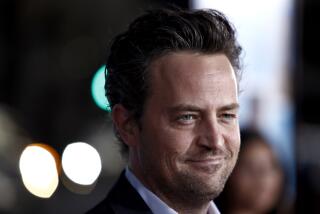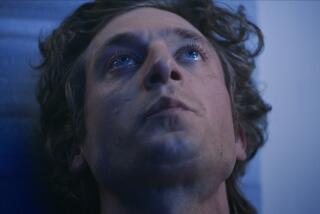A TV MOVIE TAKES A CRACK AT ‘HOT’ ISSUE
- Share via
The first big event of this year’s TV season was a two-hour CBS documentary about cocaine, “48 Hours on Crack Street.” Now, in an unusual, unplanned bit of symmetry, the season is about to end with a two-hour TV movie inspired by that program.
“Cracked Up,” a fictionalized look at a family and a friendship destroyed by crack cocaine, will air Tuesday on ABC.
“We hope we’ve addressed this realistically,” director Karen Arthur said. “We want to appeal to the youth audience and hope that through this film, kids who are contemplating putting this stuff in their throats, or have, will gain some courage not to, or to stop.”
Aaron Spelling Productions approached writer/producer Peter Lefcourt about the project last October, a few weeks after “48 Hours on Crack Street” aired. Lefcourt completed the first draft in January. ABC put it into production March 9 and scheduled an airing during the May ratings sweeps.
“They wanted it to be the first crack movie on,” Lefcourt said. “Crack is hot.”
A little too hot, in fact, for Lefcourt’s liking. An Emmy Award winner for his work on “Cagney & Lacey” (as is Arthur), he was initially wary of getting involved with a movie about crack because of the potential for exploitation.
“I didn’t want to make another ’48 Hours on Crack Street,’ ” Lefcourt said. “Movies have been made about cocaine, and they are so predictable. After a while, the audience’s eyes glaze over. They know the kids are going to get screwed up and their parents are going to tear their hair out.”
He decided to take a more intimate tack.
Lefcourt wrote a buddy story about two high school track stars who stumble into an experience with crack. One of them (played by James Wilder) becomes addicted almost immediately. The other (played by Raphael Sbarge) is frightened and repulsed by the experience.
“Cracked Up” follows the deterioration of their friendship and shows the effect of the one boy’s death on the other. A secondary plot deals with the addicted boy’s relationship with his father (played by Ed Asner) and the father’s denial of his son’s involvement with drugs.
“The big problem was to kill this kid and have a movie left,” Lefcourt said. “He dies on page 77. But that’s really where the movie gets interesting.
“I don’t want to minimize the crack problem, but my interest as a writer and producer is in the family relationship and the friendship. However, I realize that the thing that may get the movie watched is crack.”
Because the public is not fully informed about crack, Lefcourt, Arthur and ABC agreed that information about the drug should be made available within the context of the story. (Crack is a form of cocaine sold in small pieces, or “rocks.” It is cut up and smoked in special pipes.)
“It would have been unconscionable as film makers for us to have left this out,” Arthur said. “A lot of people may have never heard of crack. We had to find a way to explain it.”
So Lefcourt included a scene in which a counselor talks about crack.
“This scene was very important to us,” said Brett White, ABC’s West Coast vice president of broadcast standards and practices. “We needed to show that counseling help is available. We needed an optimistic note.”
Lefcourt doesn’t like the scene because, he said, “there’s no conflict. It’s naked exposition. But we left it in the picture because it’s important to get the message across. It’s an example of TV’s social conscience.
“I don’t think the scene stops the movie. It slows it down. However, if ‘Cracked Up’ were a feature film, we wouldn’t have had the scene.”
Although audiences have come to expect such exposition in TV movies, they may be taken aback by the scene that shows how crack is actually prepared and used. Arthur explained: “Crack is smoked in a glass pipe, and we had to show the pipe filling with smoke. To simulate crack, we tried half a dozen things before we wound up with a combination of baking soda, baby laxative and tobacco.”
Demonstrating drug-taking techniques in the interest of verisimilitude disturbs many drug experts.
Larry Stewart, a spokesman for the Entertainment Industries Council (a group founded three years ago to encourage more action by film makers and TV producers on the drug problem), is strongly opposed to any depiction of drug use on TV, even in a negative context.
“Kids don’t need a lesson on how to do it,” he said. “ ‘How-to’ is not justifiable in any case. The kid dies--so what, are you going to show other kids how to die? Experimenters out there will look at this and say, ‘Let’s try it one time.’
“(Basketball star) Len Bias tried cocaine one time. He’s dead. We’re dealing with a life-and-death issue.”
ABC’s White takes a different view.
“You have to consider these things within the context of the film,” he said. “We can’t simply talk about crack. We need to portray it. This boy dies because of what you see him do.” The first time he tries it, the whole procedure is shown.
“ABC was concerned that crack not look on screen like a wonderful experience,” Arthur said. “And, boy, as you watch this movie, you’re anything but intrigued with this drug. It’s frightening how anything can take you over and possess you like that.”
“Cracked Up” shows how deadly crack can be. However, the film is much less harsh in its treatment of marijuana.
“A key problem for us was differentiating between marijuana and crack,” Lefcourt said. “To make the story believable, we show these kids have had experience with marijuana.”
Anti-drug crusaders ask that any drug use on television be associated with adverse consequences. However, Lefcourt believes “Cracked Up” takes no position on marijuana.
“I wanted to avoid preaching. If we said marijuana killed them, kids would turn the channel off. I didn’t want to do ‘Reefer Madness’ (the 1936 film that warned that one puff of marijuana could lead to death).
“I don’t think we glamorize marijuana. But we don’t condemn it either as a gateway drug to crack.”
However, the film does indicate some correlation between the two drugs--and thus does in fact take a position against marijuana, ABC’s White said.
“I think there is a correlational implication there. We don’t say this explicitly.
“We feel that it is totally unacceptable to show the use of drugs in a positive atmosphere,” he said. “The message of ‘Cracked Up’ is overwhelmingly negative. Not in any way are we showing that crack is a pleasurable experience or that it resolves your problems.
“It’s a road to the grave.”
More to Read
The complete guide to home viewing
Get Screen Gab for everything about the TV shows and streaming movies everyone’s talking about.
You may occasionally receive promotional content from the Los Angeles Times.






